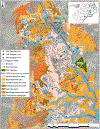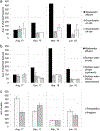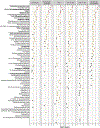Suspect screening and prioritization of chemicals of concern (COCs) in a forest-water reuse system watershed
- PMID: 31386959
- PMCID: PMC8425958
- DOI: 10.1016/j.scitotenv.2019.07.184
Suspect screening and prioritization of chemicals of concern (COCs) in a forest-water reuse system watershed
Abstract
Much research has assessed organic chemicals of concern (COCs) in municipal wastewater and receiving waters, but few studies have examined COCs in land treatment systems. Many prior studies have implemented targeted methods that quantify a relatively small fraction of COCs present in wastewater and receiving waters. This study used suspect screening to assess chemical features in ground- and surface waters from a watershed where secondary-treated wastewater is irrigated onto 900 ha of temperate forest, offering a more holistic view of chemicals that contribute to the exposome. Chemical features were prioritized by abundance and ToxPi scoring across seasonal sampling events to determine if the forest-water reuse system contributed to the chemical exposome of ground- and surface waters. The number of chemical features detected in wastewater was usually higher than on- and off-site ground- and surface waters; in wastewater, chemical features trended with precipitation in which greater numbers of features were detected in months with low precipitation. The number of chemical features detected in off- and on-site waters was similar. The lower overlap between chemical features found in wastewater and downstream surface waters, along with the similar numbers of features being detected in upstream and downstream surface waters, suggests that though wastewater may be a source of chemicals to ground and surface waters on-site, dissipation of wastewater-derived features (in number and peak area abundance) likely occurs with limited off-site surface water export by the forested land treatment system. Further, the numbers of features detected on site and the overlap between wastewater and surface waters did not increase during periods of low rainfall, counter to our initial expectations. The chemical features tentatively identified in this watershed appear common to features identified in other studies, warranting further examination on the potential for resulting impacts of these on humans and the environment.
Keywords: Exposome; Forest; HRMS; Suspect screening; Wastewater.
Copyright © 2019 Elsevier B.V. All rights reserved.
Figures





Similar articles
-
Suspect-screening analysis of a coastal watershed before and after Hurricane Florence using high-resolution mass spectrometry.Sci Total Environ. 2021 Aug 15;782:146862. doi: 10.1016/j.scitotenv.2021.146862. Epub 2021 Mar 31. Sci Total Environ. 2021. PMID: 33839655
-
Non-target and suspect-screening analyses of hydroponic soybeans and passive samplers exposed to different watershed irrigation sources.Sci Total Environ. 2022 Jun 20;826:153754. doi: 10.1016/j.scitotenv.2022.153754. Epub 2022 Feb 16. Sci Total Environ. 2022. PMID: 35182644
-
De facto Water Reuse: Investigating the Fate and Transport of Chemicals of Emerging Concern from Wastewater Discharge through Drinking Water Treatment Using Non-targeted Analysis and Suspect Screening.Environ Sci Technol. 2024 Feb 6;58(5):2468-2478. doi: 10.1021/acs.est.3c07514. Epub 2024 Jan 22. Environ Sci Technol. 2024. PMID: 38252456
-
Chemicals of emerging concern in the Great Lakes Basin: an analysis of environmental exposures.Rev Environ Contam Toxicol. 2010;207:1-93. doi: 10.1007/978-1-4419-6406-9_1. Rev Environ Contam Toxicol. 2010. PMID: 20652664 Review.
-
Towards sustainable water reuse: A critical review and meta-analysis of emerging chemical contaminants with risk-based evaluation, health hazard prediction and prioritization for assessment of effluent water quality.J Hazard Mater. 2024 Dec 5;480:136175. doi: 10.1016/j.jhazmat.2024.136175. Epub 2024 Oct 15. J Hazard Mater. 2024. PMID: 39461297 Review.
Cited by
-
The Chemical and Products Database v4.0, an updated resource supporting chemical exposure evaluations.Sci Data. 2025 Jun 6;12(1):950. doi: 10.1038/s41597-025-05240-0. Sci Data. 2025. PMID: 40481042 Free PMC article.
-
Novel and legacy per- and polyfluoroalkyl substances in humans: Long-term temporal variability and metabolic perturbations.Environ Int. 2025 Jul;201:109590. doi: 10.1016/j.envint.2025.109590. Epub 2025 Jun 6. Environ Int. 2025. PMID: 40516284
References
-
- Arias-Estévez M, López-Periago E, Martínez-Carballo E, Simal-Gándara J, Mejuto JC, García-Río L, 2008. The mobility and degradation of pesticides in soils and the pollution of groundwater resources. Agric. Ecosyst. Environ 123, 247–260. 10.1016/j.agee.2007.07.011. - DOI
-
- Bastian RK, 2005. Interpreting science in the real world for sustainable land application. J. Environ. Qual 34, 174–183. - PubMed
-
- Benson R, Conerly OD, Sander W, Batt AL, Boone JS, Furlong ET, Glassmeyer ST, Kolpin DW,Mash HE, Schenck KM, Simmons JE, 2017. Human health screening and public health significance of contaminants of emerging concern detected in public water supplies. Sci. Total Environ 579, 1643–1648. 10.1016/j.scitotenv.2016.03.146. - DOI - PMC - PubMed
Grants and funding
LinkOut - more resources
Full Text Sources

